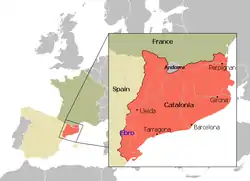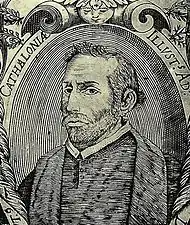Catalan Republic (1641)
The Catalan Republic (Catalan: República Catalana, IPA: [rəˈpubːlikə kətəˈlanə]) was a short-lived independent state under French protection proclaimed in 1641 by the States-General of Catalonia led by Pau Claris, during the Reapers' War.[1]
Catalan Republic | |||||||||
|---|---|---|---|---|---|---|---|---|---|
| 1641 | |||||||||
 Location of the Catalan Republic | |||||||||
| Status | Republic under French protection | ||||||||
| Capital | Barcelona | ||||||||
| Common languages | |||||||||
| Religion | Roman Catholicism | ||||||||
| Demonym(s) | Catalan | ||||||||
| Government | Republic | ||||||||
| President of the Deputation | |||||||||
• 1641 | Pau Claris | ||||||||
| Legislature | States-General | ||||||||
| Historical era | Reapers' War | ||||||||
• Proclaimed | 17 January 1641 | ||||||||
• Louis XIII of France appointed Count of Barcelona | 23 January 1641 | ||||||||
| Currency | Croat and others | ||||||||
| |||||||||
| Today part of | ∟ | ||||||||
The States-General of Catalonia, headed by the President of the Deputation of the General of Catalonia (or Generalitat) Pau Claris, proclaimed the Catalan Republic on January 17, 1641. On January 23, 1641, the Braços Generals led by Pau Claris proclaimed Louis XIII of France as Count of Barcelona, putting the Principality of Catalonia under French sovereignty. Louis XIII was succeeded upon his death in 1643 by Louis XIV (the 'Sun King'), who remained Count of Barcelona until 1652, when Catalonia was reincorporated into the Spanish Monarchy.
History


During the Reapers' War which started in 1640 (and included as a part of the Franco-Spanish War) the States-General of Catalonia (Catalan: Junta de Braços or Braços Generals), an extraordinary council of representatives of the Catalan Courts without the king, summoned by the Generalitat, sought support in France and Bernard du Plessis-Besançon was appointed plenipotentiary of the King of France on August 29, 1640. On October 27 an agreement was finally reached with du Plessis-Besançon to obtain supplies against the army of the King of Spain directed by Pedro Fajardo, Marquis of los Vélez.
With the victory of the army of the Marquis of Los Vélez in Tarragona on December 23, it continued its advance towards Barcelona, while the French army of d'Espenan proceeded to leave Catalonia to France at the beginning of January 1641. Negotiations with the French intensified, on January 3 a delegation of three Catalans met with Cardinal Richelieu who assured them protection if they were a republic like Genoa. In this sense on January 14 du Plessis-Besançon went at the residence of the president of the Deputation of the General of Catalonia or Generalitat, Pau Claris, to still conferring.[2] From this negotiation, on January 16, Pau Claris presented a proposal before the States-General by which the King of France agreed to put the Principality under his protection if Catalonia changed its government to a republic. On 17 January 1641, the States-General of Catalonia proclaimed the Catalan Republic under French protection for the first time. A week later, following the defeat of the Catalan army in the Battle of Martorell, near Barcelona, du Plessis-Besançon managed to convince the Catalan authorities that the help they needed could only be obtained from France if they recognized Louis XIII of France as sovereign. Pau Claris appealed on 23 January to Louis XIII, recognizing him as Count of Barcelona (as Louis I) and placed the Principality of Catalonia under French sovereignty.
On January 26, 1641, at the end of the Battle of Montjuïc, the army of Philip IV was defeated by a Franco-Catalan army and had to withdraw. Pau Claris died a month later. Louis XIV was titled as Count of Barcelona in succession to his father in 1643. Finally, the dismissal of the Count-Duke of Olivares, the ravages caused by the famine and the plague, as well as the commitment made by Philip IV to respect the Catalan constitutions and institutions, put an end to the war in 1652, and the Principality of Catalonia was reincorporated into the Monarchy of Spain.[3]
Part of a series on the |
|---|
| History of Catalonia |
 |
| Timeline |
References
- Gelderen, Martin van; Skinner, Quentin (2002). Republicanism: Volume 1, Republicanism and Constitutionalism in Early Modern Europe: A Shared European Heritage. Cambridge University Press. p. 284. ISBN 9781139439619
- Coll i Alentorn, Miquel (1992). Història I. L'Abadia de Montserrat. p. 427 ISBN 9788478262991
- Florensa i Soler, Núria (2004). La declinación de la monarquía hispánica en el siglo XVII. Univ. de Castilla La Mancha. ISBN 8484272966.